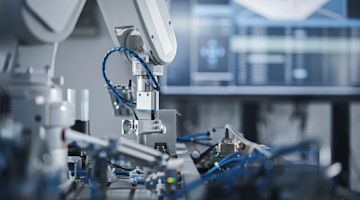Adding automation or other features to new machines will increase their productivity but also tends to drive up their value. Tracking the average value of machine orders over time is a good way to approximate the demand for automation or other technological improvements intended to increase productivity. The average value of machines can be tracked using data from the U.S. Manufacturing Technology Orders (USMTO) Report published by AMT – The Association For Manufacturing Technology. This article will explore the recent trends in the average value of new metal cutting machines and then overlay relevant economic data series.
Follow the Money
Following the recession caused by COVID-19 shutdowns, the average order value of cutting machines hit bottom in May 2020 but has been sharply going up since. Looking at the technology split, specifically within the lathe and machining center categories, we can see the unit share of simultaneous 5-axis machining centers and the share of lathes with either a Y- or B-axis have remained quite stable, indicating the increased value is most likely the effect of added automation within a product category rather than demand shifting to inherently higher-value machines.
Typically, as labor becomes scarce, wages rise, and increasing capacity through additional hires becomes more costly. This is when it becomes more cost effective for firms to use automation to increase productivity. By overlaying the average cutting machine value with the U.S. unemployment rate, several interesting trends emerge at different times (see The Big Picture on page 19).
Automation Increases With Employment
Prior to the Great Recession, there was a moderate inverse relationship between unemployment and average machine value. In the 19 months after the end of the Great Recession, there was a strong inverse relationship, and, similarly, in the 19 months since the end of the COVID-19 recession, there has been a significant inverse relationship. This trend seems logical because rapid drops in unemployment, as are often seen following recessions, are associated with a rapid rise in wages, making additional investment in automation more attractive.
Paradoxically, for much of the period between the end of the Great Recession and the onset of the COVID-19 recession, average machine values were relatively stable despite historically low levels of unemployment. A likely explanation is that the protracted expansion following the Great Recession meant unemployment fell at a more gradual pace than in previous recoveries. Combined with the persistently low inflation at the time, upward wage pressures were kept relatively low, negating some of the benefits of automation.
The machine order data used in this article is from USMTO, which is released the second Monday of each month. If you are a builder or distributor of manufacturing technology, you can receive more granular data by becoming a participant. If you have any questions or would like to participate, please visit USMTO.com.






